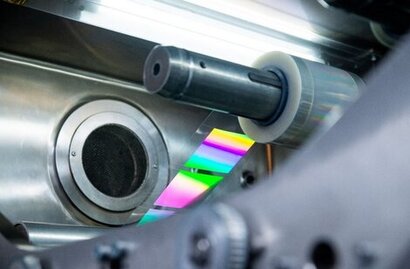
Perovskite has long been lauded as the next generation of solar power. It’s lightweight, flexible, and highly efficient – meaning it can be installed in places silicon cannot.
Traditional silicon solar panels are heavy and rigid – which limits where you can put them. Almost 30 percent of commercial rooftops worldwide can’t support their weight. This helps explain why only 2 percent of buildings globally have solar panels – despite the sun giving earth enough energy in an hour to power the whole world for a year.
Making silicon panels ironically comes with a major carbon footprint. Plus 91 percent are made in China – a supply chain risk in an era when governments are worried of depending upon rivals for energy.
However, silicon still dominates because manufacturing perovskite film has proved too hard to scale up. The challenge is that qualities which make perovskite so useful also make manufacturing a nightmare. Manufacturing defects are the main reason why perovskite has not yet achieved its potential.
Power Roll use a combination of microgrooves and vacuum forming to make film which is less than a millimetre thick and 25 times lighter than even the lightest silicon panels. Creating such thin film at scale makes quality control especially tough. Each individual solar cell Power Roll makes is 1/50th of the width of a human hair – far too small to be inspected visually. The team at Queen Mary and Power Roll aim to solve this.
Queen Mary scientists led by Dr Stoichko Dimitrov are developing in-situ optical analysis technology which Power Roll will integrate into their manufacturing equipment for quality control and R&D.
“The technology will analyse how light interacts with the material as it’s being produced, thereby providing essential data for monitoring and improving the quality of the film produced in real time” said Dr Stoichko Dimitrov. “This will enable PowerRoll to scale up production and make perovskite film a reality.”
Dr Dimitrov was the first to develop portable in-situ optical analysis technology for enhancing the performance of printed photovoltaic perovskite materials. This partnership with PowerRoll will be the first time the technology has been applied in an industrial setting. Together, Queen Mary and Power Roll are demonstrating that optimisation can be achieved much faster than the standard R&D process.
“Quality control is the key to turning perovskite from concept to reality” added Dr Dave Barwick, Technical Manager at Power Roll. “We’re proud to be working with Queen Mary University of London to achieve this. We’re making solar that goes where other solar solutions can't, and we’re doing it without using rare and precious earth materials. Queen Mary’s expertise in optical analysis will help us scale up production by ensuring every microscopic solar cell is of the highest quality.”
The rewards for the environment and economy could be substantial. Such a lightweight film can be placed almost anywhere. Power Roll estimates there are 12 billion square metres of low-load-bearing rooftops in the UK which could be generating green electricity at less than a quarter of the current grid cost – yet aren’t because traditional silicon panels are too heavy. This represents a market in the region of £250 billion.
The project is funded by Innovate UK. Queen Mary is hiring a post-doctoral research associate to play a central role in translating advanced research into scalable production methods.
For additional information:

